Tree Felling Techniques, Safety, and Best Practices for Professional Loggers
- August 16, 2024
- 0 comment
Tree felling is one of the most critical tasks in forestry, requiring not only skill and precision but also a deep commitment to safety. For professional loggers, mastering tree felling techniques is essential not just for efficiency, but also for ensuring the safety of themselves and their teams.
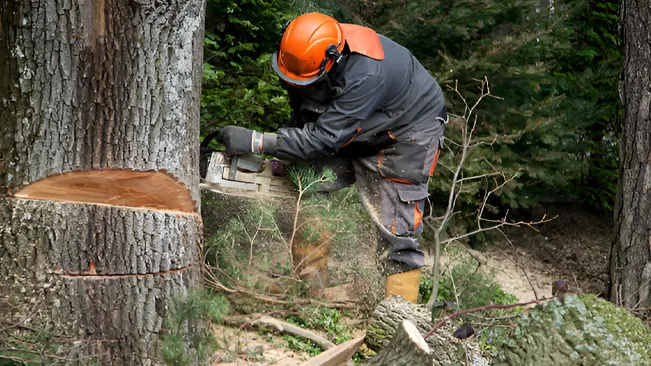
It involves a series of carefully planned steps, from site assessment to precise cutting, with safety as the top priority for professional loggers.
Felling Trees: Preparation and Planning
1. Site Evaluation
Before making any cuts, thoroughly evaluate the site by assessing the tree’s species, size, lean, and overall health.
Trees with significant lean may require specialized techniques for safe felling. Also, evaluate the surrounding terrain and weather conditions, as these factors can affect the tree’s fall and the operation’s safety.
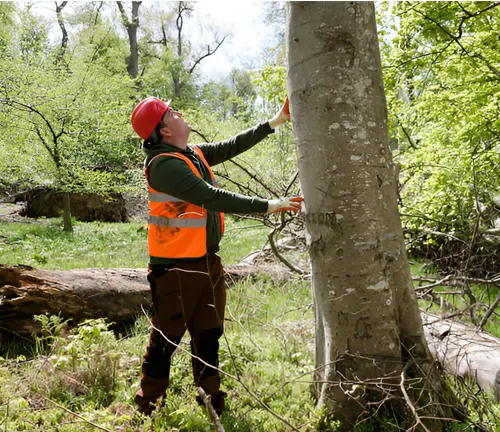
Identifying hazards such as widow-makers, snags, and unstable ground is crucial to avoid interference during felling. By carefully assessing these factors, you can develop a clear and safe felling plan.
2. Preparing the Felling Area
After evaluating the site, prepare the felling area by removing any debris or underbrush around the tree’s base to ensure nothing interferes with the cutting process or escape route.
Establish a clear escape route leading away from the tree at a 45-degree angle, ensuring it is free of obstacles for a quick retreat. Before making any cuts, ensure all team members are aware of this escape route.
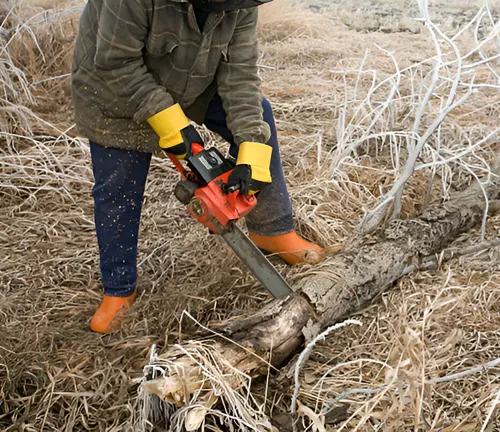
Set up safety zones to maintain a safe distance from the tree and equipment. Lastly, establish clear communication protocols to alert everyone when the tree is about to fall, reducing the risk of accidents.
Notching and Cutting Techniques
1. Understanding Notches
The notch is the primary tool for controlling the direction in which a tree will fall. There are several types of notches used in professional logging, each with specific applications:
Conventional Notch
This method is commonly used for straightforward tree felling, involving a 45-degree notch on the side of the tree facing the intended fall direction. It is easy to execute and effective for most felling situations.
Humboldt Notch
Ideal for steep terrain, the Humboldt notch creates a low stump, making it preferred when minimizing stump height is crucial. The notch is cut with the horizontal cut first, followed by an angled cut above it.
Open-Face Notch
Known for providing the best control, the open-face notch involves a larger, 70-degree or more opening. This notch greatly reduces the chances of the tree kicking back and allows for a more controlled and predictable fall.
2. Executing the Notch
Creating a proper notch is critical for successful felling, starting with the top cut at the correct angle based on the notch type. The notch should be about one-third of the tree’s diameter, with its depth determining the hinge wood’s size, which controls the tree’s fall.
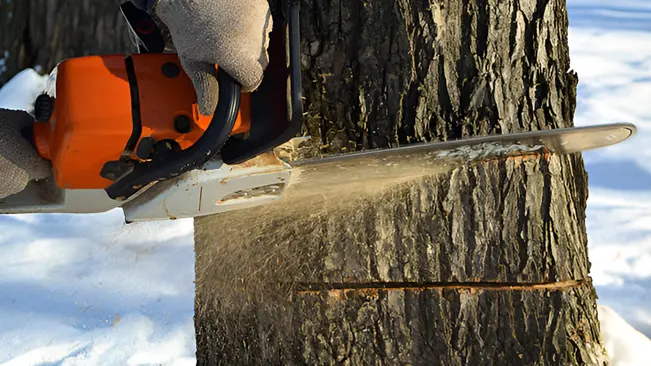
The hinge wood, the uncut part between the notch and back cut, guides the tree’s fall. If too thin, the tree may fall too fast or incorrectly; if too thick, it may not fall or could split, making precision crucial for safety.
Advanced Timber Felling Procedures
Implementing the Back Cut
After the notch is made, the next step is the back cut. This cut should be made on the opposite side of the notch and slightly higher than the bottom of the notch. This positioning helps create a strong hinge, which is essential for controlling the fall.
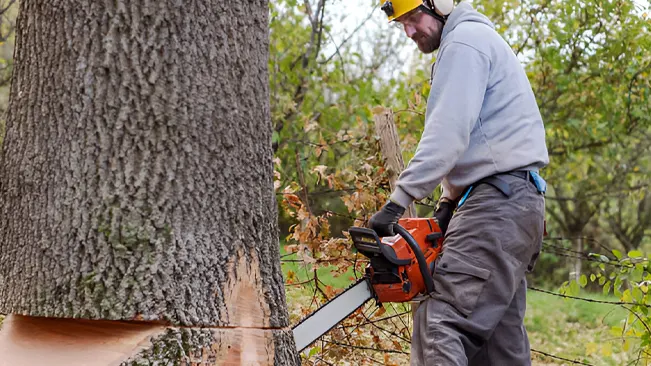
1. Location of the Back Cut:
The back cut should be made on the opposite side of the notch, positioned slightly higher than the bottom of the notch. This placement helps create a strong hinge, which is crucial for controlling the tree’s fall.
2. Execution of the Back Cut:
Avoid cutting too deep, which can weaken the hinge and cause premature tree fall, or too shallow, which can leave the tree standing and increase the risk of an uncontrolled fall. The goal is to complete the back cut in a way that allows the tree to fall gradually and under control.
Managing Large and Leaning Trees
Challenges of Large and Leaning Trees
Larger trees or those with significant lean pose challenges that require advanced techniques such as boring cuts or wedges. These methods provide better control and safety when felling difficult trees.
1. Boring Cuts
Boring cuts are particularly useful for large diameter or heavily leaning trees, involving a cut through the tree’s center before the back cut. This technique ensures the hinge wood is set effectively, offering greater control over the tree’s fall.
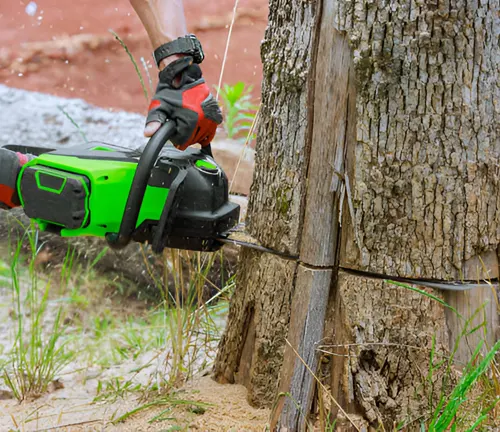
2. Using Wedges
Wedges are essential for managing difficult fells, especially in guiding leaning trees in the desired direction. Proper use of wedges prevents the tree from leaning back onto the saw and requires practice to ensure safety.
Complex Tree Felling Challenges
Felling Trees with Heavy Lean
Trees with a significant lean pose unique challenges. The key to safely felling these trees is to adjust your notching and cutting techniques to account for the additional forces at play. For example, you may need to create a deeper notch or use additional wedges to counteract the lean.
Felling Against the Natural Lean
In some cases, you may need to fell a tree against its natural lean, such as when avoiding structures or other trees. This requires advanced techniques, including the use of multiple wedges or ropes to guide the tree’s fall.

Extreme caution is necessary in these situations, as the forces involved can be unpredictable.
Safety Protocols
When dealing with problem trees, extra safety measures are essential. Ensure all team members are aware of the specific challenges and risks involved. Use specialized tools, such as wedges or ropes, and never rush the process. Patience and careful planning are key to safely handling these complex felling operations.
Limbing and Bucking: Post-Felling Operations
Limbing is the process of removing branches from a felled tree, requiring careful attention to safety and technique to prevent injury. Bucking involves cutting the trunk of the felled tree into manageable sections, which also demands precise execution to avoid accidents and ensure the logs are appropriately sized for transport or further processing.
Safe Limbing Practices
- Stand on the Uphill Side: Always position yourself on the uphill side of the tree if it’s on a slope. This helps prevent the tree from rolling onto you during the limbing process.
- Maintain Balanced Stance: Keep a balanced stance and hold the saw close to your body for better control while limbing. This reduces the risk of losing control of the saw or slipping.
- Assess Tension in Branches: Before cutting any branch, check for tension, especially in branches under compression (commonly called “spring poles”). These branches can snap back violently when cut, so it’s important to release the tension gradually and safely.
- Use Proper Cutting Technique: Use proper cutting techniques to safely release tension in branches, reducing the risk of injury.
- Work from the Base Upward: Start limbing from the base of the tree and work your way upward, clearing branches methodically and ensuring a safe work environment.
Effective Bucking Techniques
- Secure Footing: Make sure your footing is stable and secure before making any cuts. This helps you maintain control of the saw and reduces the risk of accidents.
- Use the Chain Brake: Engage the saw’s chain brake when moving between cuts. This prevents accidental starts and enhances safety.
- Plan Your Cuts: When bucking large logs, be aware of their potential to roll or shift. Plan your cuts to maintain control over the log’s movement, and make sure the log is stable before cutting.
- Stay Aware of Surroundings: Always stay alert to your surroundings to avoid accidents, particularly when working with large or heavy logs.
- Control the Log’s Movement: Properly control the log’s movement to avoid unexpected shifts that could cause injury or damage.
Safety Guidelines for Tree Felling Operations
Essential Protective Gear
Personal Protective Equipment (PPE) is a non-negotiable aspect of tree felling safety.
Ensure that all workers are equipped with helmets, safety goggles, hearing protection, gloves, chainsaw chaps, and steel-toed boots. Each piece of gear is designed to protect against specific hazards, from falling branches to chainsaw injuries.

Communication and Team Coordination
Clear communication is vital in any tree felling operation. Establish hand signals or radio communication to ensure that everyone is aware of each step in the process. Before any cuts are made, hold a briefing to confirm that all team members understand their roles and the escape routes. In the event of an emergency, having a clear plan can save lives.
Conclusion
Tree felling is a complex task that requires skill, precision, and an unwavering commitment to safety. By following these techniques and best practices, professional loggers can ensure that their work is carried out efficiently and safely.
Remember, the key to successful tree felling lies in thorough preparation, precise execution, and constant attention to safety. Continuous learning and adherence to these principles will help you master the art of tree felling and maintain the integrity of the forest.
Frequently Asked Questions (FAQ’s)
- What is the safest notch to use for tree felling?
The open-face notch is the safest because it gives the best control over the tree’s fall and reduces the risk of kickback. - How do I determine the correct hinge size for felling a tree?
The hinge should be about 10% of the tree’s diameter and 80% of the tree’s width at breast height. - When should I use a boring cut?
Use a boring cut for large or leaning trees to better control the fall by setting the hinge properly. - What precautions should I take when felling a tree with a heavy lean?
Use wedges and possibly a boring cut to guide the tree safely and prevent it from leaning back onto the saw. - How can I avoid common mistakes during the back cut?
Don’t cut too deep, and make sure the back cut is slightly higher than the bottom of the notch to keep the hinge strong. - What should I do if the tree does not fall after the back cut?
Step back, assess the situation, and use wedges. Never try to push or pull the tree by hand. - How do I set up a proper escape route when felling trees?
Clear an escape path at a 45-degree angle away from the tree, free of obstacles, for a quick retreat. - What are the risks of using improper notches?
Improper notches can cause the tree to fall the wrong way, increase kickback, or cause the tree to split, leading to accidents. - Why is it important to maintain communication during a tree felling operation?
Clear communication helps prevent accidents and ensures everyone knows when the tree is about to fall. - What protective gear is essential for safe tree felling?
Essential gear includes a hard hat, safety goggles, hearing protection, gloves, chainsaw chaps, and steel-toed boots.

Jordan Blake
Forestry AuthorJordan Blake is a forestry expert with over 15 years of experience in arboriculture and community education. Passionate about sustainable forest management, Jordan regularly writes for Forestry.com and Tree Care Magazine. Holding certifications in tree health assessments and urban forestry management, Jordan conducts workshops to educate the public on sustainable practices. Jordan has a degree in Environmental Science and enjoys hiking and photography in their free time.




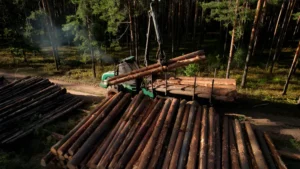


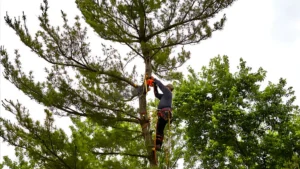



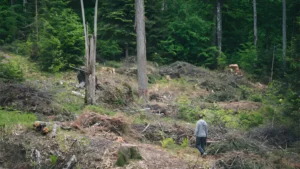

Leave your comment